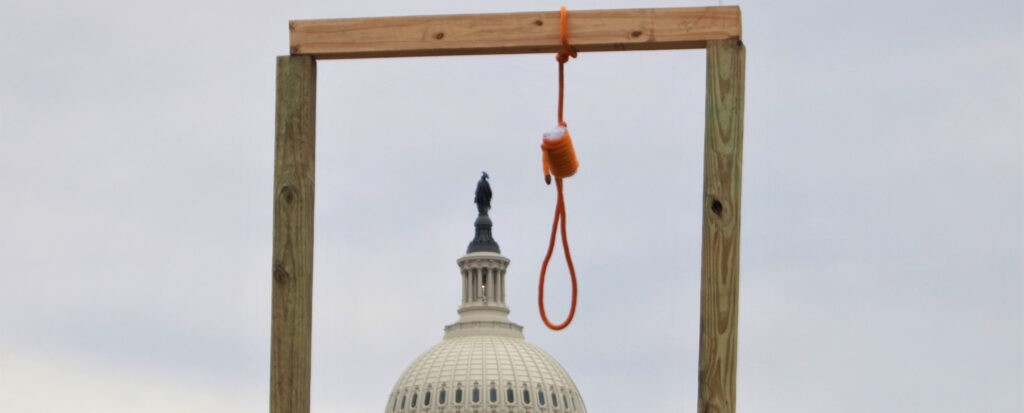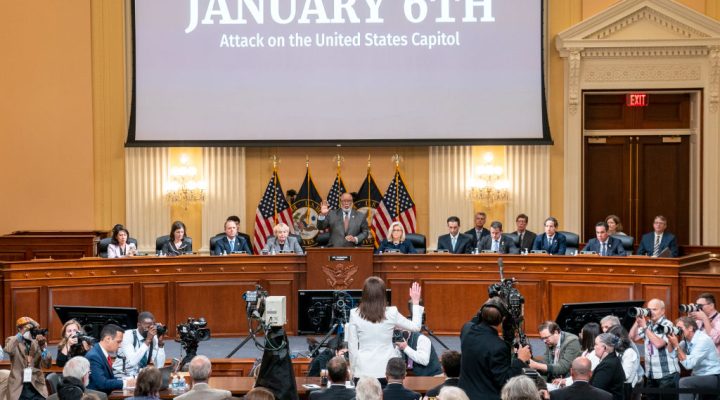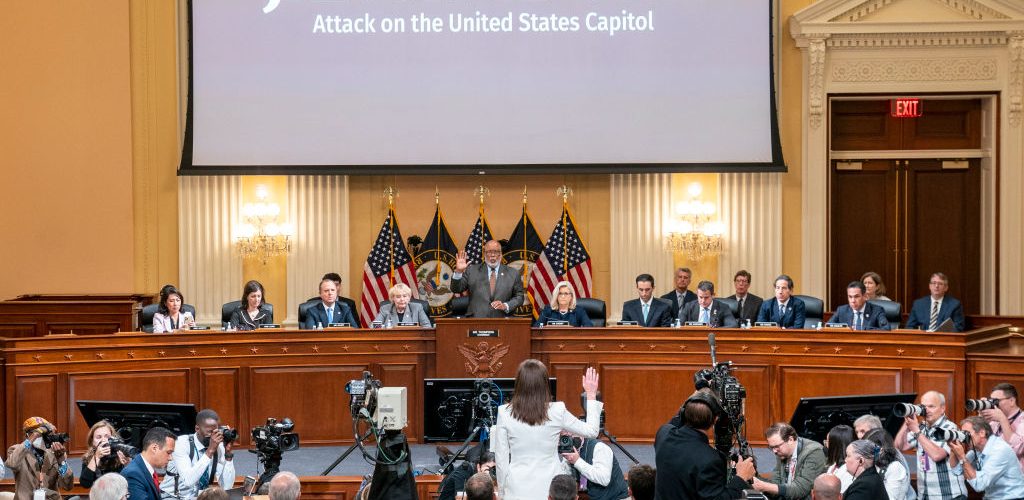The hearings conducted by the House Select Committee to investigate the January 6th attack on the U.S. Capitol have highlighted the powerful role that white Christian nationalism played in the attack on the Capitol. The Congressional Committee featured Trump ally Roger Stone firing up a crowd of pro-Trump protestors the day before the insurrection with this statement: “This is nothing less than an epic struggle for the future of our country. Between dark and light. Between the godly and the godless, between good and evil, and we will win this fight or America will step off into years of darkness.”
Among the insurrectionists, there were crosses, Bible verses, “Jesus Saves” signs and “Jesus 2020” flags that mimicked the design of the Trump flags, intermingled with anti-semitic symbols and slogans.
The closing frame of the deeply disturbing House Committee video of the violence that day featured two insurrectionists standing side by side on the scaffolding built for Biden’s inauguration, each waving a flag. One was a Trump flag. The other was the Christian flag that stands on the dais behind the pulpit in Protestant churches across America.
Put this all in black and white, and the scene could be mistaken for a KKK event from a previous era. Indeed, given the resurgence of white Christian nationalism in American public life today, you might be forgiven for thinking the cultural clocks had been turned back a century, to the 1920s.
That violent era was launched in what NAACP field secretary James Weldon Johnson dubbed “Red Summer,” when white terrorism and violence toward African Americans broke out in more than three dozen cities across the United States. The anti-Jewish, anti-Catholic, anti-immigrant, and anti-Black currents so prevalent throughout that decade were powered by a white supremacist belief that America was ordained by God as a promised land to be run by white, native-born, Protestant men.
This worldview was held not only by terrorist groups like the KKK. It was also widely shared among Americans who could lay claim to being white. And in this era, it was commonly justified and legitimated in white Protestant pulpits, evangelical and mainline, South and North.
This earlier form of white Christian nationalism was defeated, in part, by a movement of Catholic, Jewish, and Protestant leaders who believed in a more open, inclusive America.
This earlier form of white Christian nationalism was defeated, in part, by a movement of Catholic, Jewish, and Protestant leaders who believed in a more open, inclusive America.
As Kevin Schultz details in his book Tri-Faith America, the National Conference for Christians and Jews emerged in the late 1920s as a direct response to the KKK and quickly organized a host of interfaith activities across the nation. Perhaps most importantly, they offered early 20th century Protestants—in the conjured phrase “Judeo-Christian” — a broader way of understanding the nation and their place in it.
To be sure, this term had its shortcomings: “Judeo-Christian” had no historical referent nor theological pedigree; it remained limited to religions that could be located within Protestant understandings of their Bible; and despite the semantic equality of the two adjectives separated by a hyphen, it did little to blunt Christian supersessionism.
But the idea of a Judeo-Christian nation was nonetheless a powerful and important development. It opened the door to Jews and Catholics— many of whom at that time were recent immigrants and largely poor — welcoming them as recognized members of the American religious landscape. It redrew white Protestants’ mental maps of America.
As Thomas Jefferson understood, a democracy is not established once for all time. Each generation must recommit itself to renewing its institutions and affirming its principles, to defending the hard-won victories of the past against threats in the present. It’s not surprising that we find ourselves today, once again, facing down regressive white Christian nationalist forces.
A recent report by the Baptist Joint Committee and the Freedom From Religion Foundation demonstrates that the January 6th insurrection is part of a broader white Christian nationalist movement that sees itself as reclaiming the country. According to a 2021 PRRI survey, while only 30% of Americans agree that “God intended America to be a new promised land where European Christians could create a society that could be an example to the rest of the world,” that number rises to dangerous levels among groups comprising the conservative base in U.S. politics, including majorities of Republicans (53%) and white evangelical Protestants (52%).
Moreover, white Americans who embrace this white Christian nationalist version of history are more than four times as likely as those who disagree to believe that “true American patriots may have to resort to violence to save the country” (43% vs. 10%).

A gallows erected outside the U.S. Capitol on Jan. 6, 2021, by supporters of Donald Trump. (Photo by Tyler Merbler via Flickr; used by Creative Commons license)
It’s also not surprising that the tools past generations used to protect democracy are insufficient for the work today. We believe the current resurgence of white Christian nationalism, while deeply worrisome, may provide an opportunity for Americans to create an analogous paradigm shift to protect our democracy.
Jews and Catholics were the (relative) newcomers to the American civic landscape in the early 20th century. There were very few openly practicing Muslims, Hindus, Buddhists, Jains, Sikhs or Bahai’s in the nation at the time. And there were few who openly shunned religion altogether.
Over the last half century, the American religious landscape has changed dramatically. Since the passing of the Hart-Cellar Immigration Act of 1965, which did away with America’s longstanding Europe-first immigration policies, many other religious communities have immigrated, established themselves and grown.
Today, there are as many Muslims in the United States as Lutherans, and twice as many Buddhists as Episcopalians. Moreover, the median age of Muslims, Hindus and Buddhists is some 20 years younger than the median age of white Christians.
Today, there are as many Muslims in the United States as Lutherans, and twice as many Buddhists as Episcopalians. Moreover, the median age of Muslims, Hindus and Buddhists is some 20 years younger than the median age of white Christians.
This growing religious diversity impacts virtually every facet of American life. Muslim congregational prayer is Friday afternoon, not Sunday morning; this shift in traffic patterns will impact zoning considerations in many towns and municipalities as Muslims establish mosques. Many Jains, Buddhists and Hindus are vegetarian; this will change what is served in the cafeterias of schools and businesses. And the pandemic was a reminder that Americans may seek the guidance of a wide array of religious leaders alongside their doctors on matters like whether to take a new vaccine.
Despite its limitations, “Judeo-Christian” did good work for more than half a century, moving us beyond a white Anglo-Saxon Protestant America. It was most certainly better to be a Catholic or a Jew in 1990’s America than in 1930’s America. Indeed, one measure of America’s progress on this front is that, over the last century, the term’s usage shifted from a call to embrace a more pluralistic future by the left to a preservation of a more monocultural past by the right.
Despite the loud, angry voices most visible in the media, data from a recent PRRI survey demonstrate that most Americans embrace these differences. Fully seven in ten Americans say they are proud to live in a religiously diverse nation.
Across our history, through the efforts of patriots in every generation, the United States has repeatedly found our way back from anti-democratic waves of white Christian nationalism. When we have succeeded, it is because we have clung to our best virtues rather than our worst instincts, our democratic principles rather than our tribal fears.
It’s time to say good-bye to “Judeo-Christian” America. But we can learn from its example — especially the way it creatively expanded our civic and moral imagination — as we write the next chapter in the great history of American religious diversity.

Robert P. Jones (Photo by Noah Willman)

Eboo Paatel (Photo by Ken Camp, Baptist Standard)
Robert P. Jones is CEO and founder of PRRI and the author of White Too Long: The Legacy of White Supremacy in American Christianity, which won a 2021 American Book Award.
Eboo Patel is president and founder of Interfaith America. His latest book is We Need to Build: Field Notes for Diverse Democracy.
This column originally appeared on Robert P. Jones’ substack #WhiteTooLong. BNG features Jones’ columns in partnership the author and PRRI.
Related articles:
New book offers tips on how to have a conversation with white Christian nationalists
Americans United says Florida is inserting white Christian nationalism in the classroom
Hashtags won’t defeat white Christian nationalism, panelists warn


